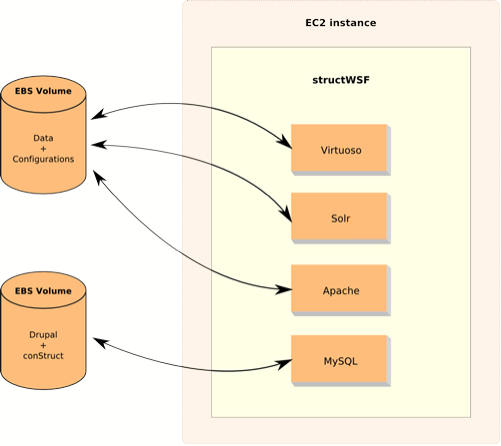

We just released a new (major) version of both structWSF and conStruct. Though some months had passed since we last released this software, we finally got the time and opportunity to make these important upgrades.Many things have changed in both packages. I don’t want to iterate all the changes in this blog post, so I would suggest you to read the changes log files here:
These new versions have greatly been impacted by the needs of our clients. We also started to introduce some new concepts we wrote about the last few months.
A really good addition to this release is the a brand new Installation Manual. Hopefully people will be able to “easily” and properly install and setup a Web server to host these two packages.
All documentation files have been updated:
- structWSF Web Service Endpoints documentation
- structWSF code documentation
- conStruct code documentation
You can download both software packages from here:
- structWSF version 1.0a4
- conStruct version 6.x-1.x-dev-4 (Drupal should create the new package within 1 day)
An Amazon EC2/EBS Architecture
Some of the changes to these new versions have been made to help create, setup and maintain Web servers that host structWSF and conStruct instances.
At Structured Dynamics, we have developed and use a server architecture that leverages Amazon computer-in-the-clouds services such as: EC2, EBS, Elastic IP in the Cloud. Such an architecture is giving us the flexibility to easily maintain and upgrade server instances, to instantly create new structWSF instances in one click (without performing all these steps everytime), etc.
You can contact us for more information about these EC2 AMIs and EBS Volumes that we developed for this purpose. Here is an overview of the architecture that is now in place:

There is a clear separation of concerns between three major things:
- Software & libraries
- Configuration files
- Data files.
We chose to put all software and libraries needed to create a stand-alone structWSF instance in an EC2 AMI. This means that all needed software to run a structWSF instance is present on the Virtuoso server running Ubuntu server.
Then we chose to put all configuration and data files on an EBS volume that we attach, and mount, on the EC2 instance. You can think about a EBS volume as a physical hard drive: it can be mounted on a server instance, but it can’t be shared between multiple instances.
By splitting the software & libraries, configuration and data files, we make sure that we can easily upgrade a structWSF server in production with the latest version of structWSF (its code base and all related software such as Virtuoso, Solr, etc). Since the configuration and data files are not on the EC2 instance, we can easily create a new EC2 instance by using the latest structWSF AMI we produced, and then to mount the configuration and data files EBS volume on the new (and upgraded) structWSF instance. That way, in a few clicks, we can fully upgrade a server in production without fear of disturbing the configuration or data files.
Additionally, we can easily create backups of configuration and data files at different intervals by using Amazon’s Snapshot technology.
Finally, we chose to put all related software and configuration files needed to run a conStruct instance in another, separate, EBS volume. That way, we have a clean structWSF AMI instance that can be upgraded at any time, and we can plug (mount) a conStruct instance (EBS instance) into a structWSF server at any time. This means that we can easily have structWSF instances with or without a conStruct instance. The same strategy can easily be used to create plugin packages that can be mounted and unmounted to any structWSF instance at any time, depending on the needs.
All this makes structWSF server instances maintenance easier, simpler and faster.